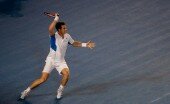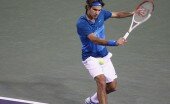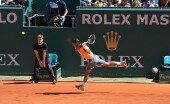Djokovic and the Art of Preserving Energy
July 20, 1937: Don Budge and Gottfried von Cramm meet in the centre court at Wimbledon in the final tie of the Davis Cup semi-final between the United States and Germany. The match, as Marshall Jon Fisher recounts in his exemplary book, A Terrible Splendor, had a significance that stretched beyond the realms of tennis and sport. Von Cramm races to a two sets to love lead, playing an exquisite, stylish brand of tennis that was nonetheless exhausting against Budge whose power game was incomparable. A closely fought third set that took a toll on both players is edged out by Budge 6-4 and with the American leading early in the fourth set, von Cramm chooses to ease up, to conserve his energy for the decider – a tactic, which ludicrous as it sounds now, was in those days considered very viable. As Fisher describes: “There is no way Cramm is going to break Budge three times in one set, he knows, and that is what he would have to do to win the fourth. He decides to conserve his energy for the fifth set. He puts up little resistance on Budge’s next two service games, wins his own without too much exertion and concedes the set six-two.”
In the final set, von Cramm speeds to a 3-1 lead, his tactics look sound, but Budge recovers superbly and ultimately succeeds 8-6. Quite conceivably, the German’s strategy of preserving energy for the deciding set was misjudged, but it was one that had worked wonderfully in the past not least for him, but for Budge too, and it was one that he had no choice but to deploy. We don’t hear of such approaches in modern-day tennis, but to believe that they are redundant would be erroneous.
It is, perhaps, safe to assume that such a method was not in Novak Djokovic’s mind at the start of the match. He would have merrily taken a straight sets victory. In the second set, he had come as close to perfection as is imaginable against Rafael Nadal. He was able to scurry across the back of the court chasing improbable balls that would have been winners against any other player, and was able to return them not so much with mere interest and purpose, but with glorious certitude.
Yet, he was broken early in the third set. His concentration levels had dropped, as is only normal after two sets of scintillating tennis, and Nadal was now beginning to exert his authority. Djokovic chose not to consume excessive energy in aiming to get back into the set. Instead he focused his efforts on beginning the fourth set in optimum physical condition. Having allowed Nadal a way back into the match early in the third set, he had two options, either to keep his efforts up and aim at breaking Nadal back – which looked unfeasible at the time considering how well Nadal was serving – or to drop his levels a bit, and ensure that he retained enough energy to launch a more sustained attack in the fourth set. He, wisely, chose the latter and broke early in the fourth to go up two games to love.
Nadal’s physical condition had, by then, understandably slumped – he had worked consistently hard throughout the first three sets – whereas Djokovic was able to find renewed vitality. Had Djokovic chased Nadal in the third set and had he failed, which was very conceivable considering the Spaniard’s improved game, both players would have begun the fourth set in almost identical physical condition. As it stood, Djokovic was the more relaxed; he was able to restore the rhythm to his game and although Nadal broke back in the set, fortuitously, the Serb’s newfound confidence meant that in his superior physical state, the victory was almost inevitable. He broke Nadal’s serve again at 4-3, served and volleyed at a tricky time at thirty-all in the next game and won his first Wimbledon, a big fat cherry that now sits atop his status as the world’s new number one player.





One Comment on "Djokovic and the Art of Preserving Energy"
yes,it was his strategy to relax and preserve energy for the 4th set and the same ploy was adopted by him in the semis against Tsongo.Gosh!what an amazing 2nd set played by him and it was really awesome chasing and returning the ball for winners.Nadal paid the price for not changing his game plan and sticking to his predictable base line bashing. Nadal was simply out-manoeuvred by the no 2 seed.